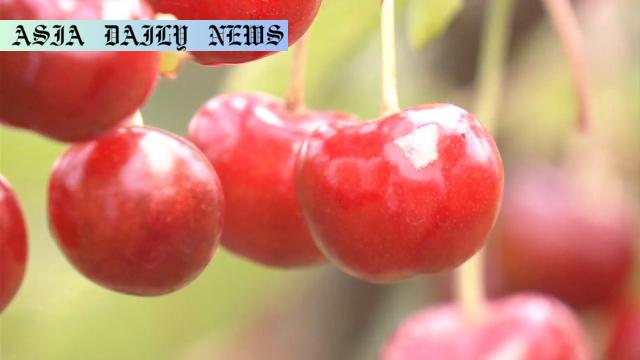Yamagata Beniou – Cherry growers report peak harvest season for this sweet variety, set to exceed last year’s output with remarkable growth.
- Key Point 1: Yamagata Beniou cherries, a premium variety, are reaching their peak harvest season in Japan’s Yamagata Prefecture.
- Key Point 2: This sweet and crisp cherry variety is highly suitable for gift-giving, boasting promising market prospects.
- Key Point 3: Yamagata Beniou’s resilience has outperformed the prefecture’s mainstay Sato Nishiki variety amid challenging weather conditions.
- Key Point 4: Shipments of Yamagata Beniou cherries are expected to double, with a target of 70 tons this year.

Introduction: Yamagata Beniou Takes Center Stage
In the picturesque northeastern region of Japan’s Yamagata Prefecture, cherry growers are celebrating the peak harvest of the Yamagata Beniou—a sweet and sizeable cherry variety that is growing in popularity and prestige. Renowned for its crisp texture and appealing sweetness, the Yamagata Beniou has quickly established itself as a prime choice for gift-giving and premium fruit markets. As growers diligently pick each fruit by hand, the variety is positioned to exceed last year’s production, signaling a bright future for this budding agricultural brand.
The Origins and Growth Potential of Yamagata Beniou
Developed by Yamagata Prefecture as a new addition to its renowned cherry repertoire, the Yamagata Beniou variety has shown promising growth since its commercial production began two years ago. Measuring an impressive 3 centimeters in diameter, this cherry boasts high sugar content and low acidity—attributes that make it particularly desirable among fruit connoisseurs. In less than three years, more than 3,080 growers have registered to cultivate Yamagata Beniou, underlining its rising appeal and the confidence growers have in its market viability.
Resilience and Growth Amid Adverse Conditions
Interestingly, the success of Yamagata Beniou comes against the backdrop of challenges faced by the region’s primary cherry variety, Sato Nishiki. Unfavorable weather during the blooming season is expected to result in a decline in Sato Nishiki’s harvest this year, further highlighting the resilience and advantages of Yamagata Beniou. This variety bloomed earlier and enjoyed more favorable conditions, enabling it to thrive. Such resilience during climate challenges hints at its role as a strong player in the region’s agricultural future.
Projection for 2023 and Market Implications
The prefecture projects shipping approximately 70 tons of Yamagata Beniou this year—a figure that more than doubles the previous year’s harvest. This achievement not only marks a significant milestone but also emphasizes its growing foothold in Japan’s premium fruit market. The cherries’ combined qualities of freshness, sweetness, and visual appeal make them ideal for both domestic consumption and overseas gifting purposes. Experts anticipate increasing interest from international markets looking for unique, high-quality produce.
A Shining Example of Agricultural Innovation
Yamagata Beniou exemplifies the power of agricultural innovation and adaptability. By introducing a new variety that balances tradition with modern market demands, the prefecture has successfully created a product that resonates with both growers and consumers. The cherry’s success serves as a template for other agricultural processes seeking to adapt to regional challenges while embracing fresh opportunities. As the harvest season progresses, one can only expect Yamagata Beniou to solidify its reputation as a premium fruit that bridges heritage and innovation.
Conclusion and Looking Ahead
As Yamagata Prefecture doubles down on its efforts to promote Yamagata Beniou cherries, the variety has emerged as a defining aspect of the region’s agricultural identity. With an expected harvest of 70 tons this year, the cherry’s future appears brighter than ever. Its unique sweetness and fresh qualities have made it a contender on both domestic and international platforms, promising continual growth and success for years to come. Japanese cherry growers can take pride in cultivating not just a fruit, but a symbol of perseverance, innovation, and excellence.



Commentary
The Growing Legacy of Yamagata Beniou Cherries
Yamagata Beniou cherries represent much more than a new variety of fruit; they embody the innovation and resilience of Japanese agriculture. In a world deeply affected by changing weather patterns and shifting consumer demands, the success of Yamagata Beniou is a testament to how strategic planning and dedication to quality can lead to remarkable results. It’s inspiring to see this relatively new cherry variety thrive, doubling its production in just a year. Such progress speaks volumes about the efforts of the cherry farmers in Yamagata Prefecture.
A Symbol of Japan’s Agricultural Ingenuity
For Japan, where tradition often meets innovation, the Yamagata Beniou is a proud symbol of agricultural ingenuity. Its success against the decline of traditional varieties like Sato Nishiki illustrates how adapting to modern challenges can yield considerable rewards. The cherry’s low acidity and crisp texture are not merely characteristics—they are carefully nurtured traits that give it a competitive edge in the increasingly selective fruit market. Moreover, this variety’s ability to withstand warmer climates makes it an invaluable asset as climate concerns grow more urgent.
A Sweet Future
The story of Yamagata Beniou encourages us to think about the potential of agricultural advancements in other crops around the world. If such care and innovation can foster success in cherries, what could similar levels of effort achieve in other areas? The farmers and developers behind Yamagata Beniou have proven that perseverance, coupled with foresight and a willingness to innovate, can yield extraordinary results. Consumers worldwide should keep an eye on Yamagata Beniou—it’s a fruit with a story worth savoring.